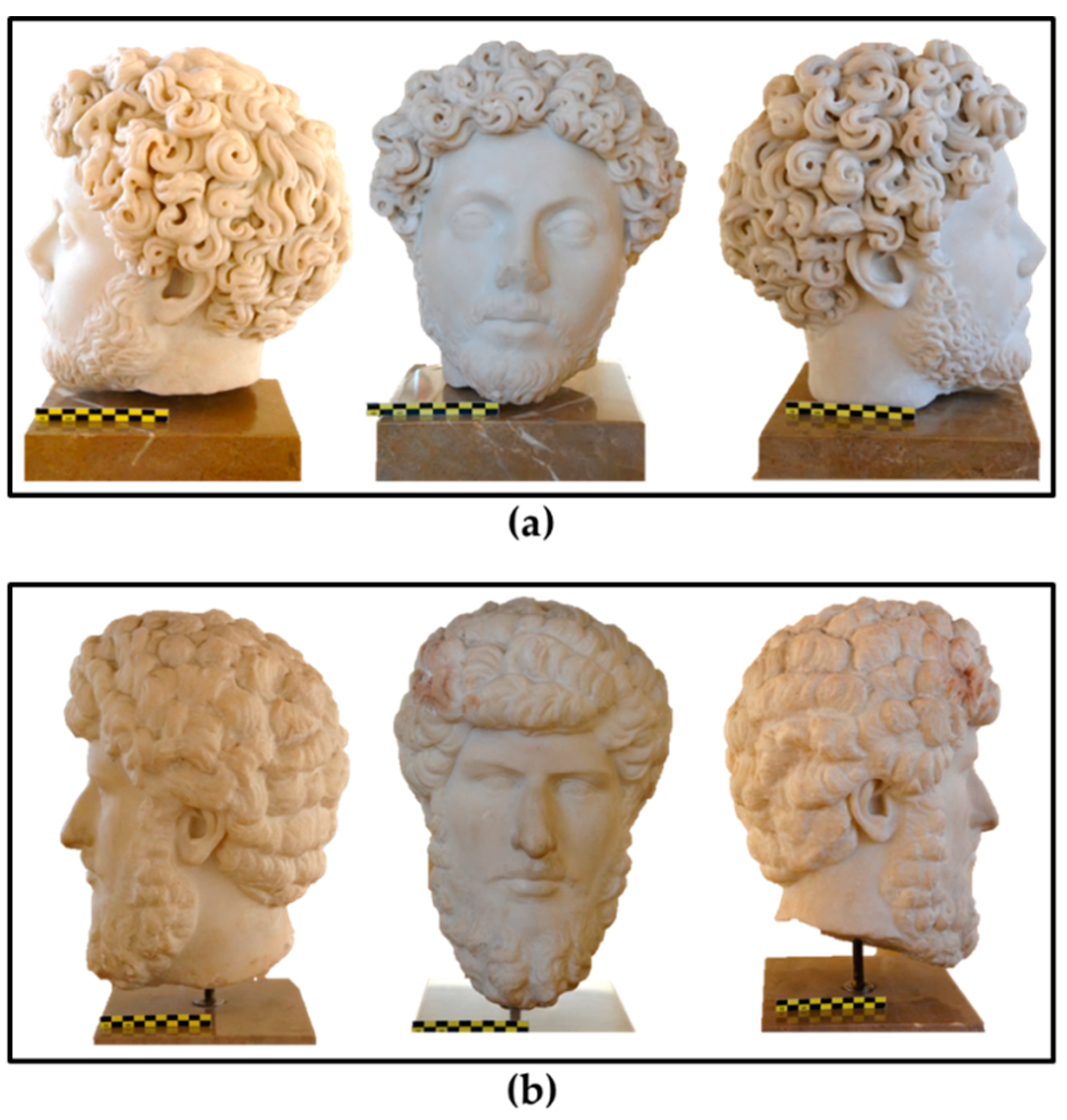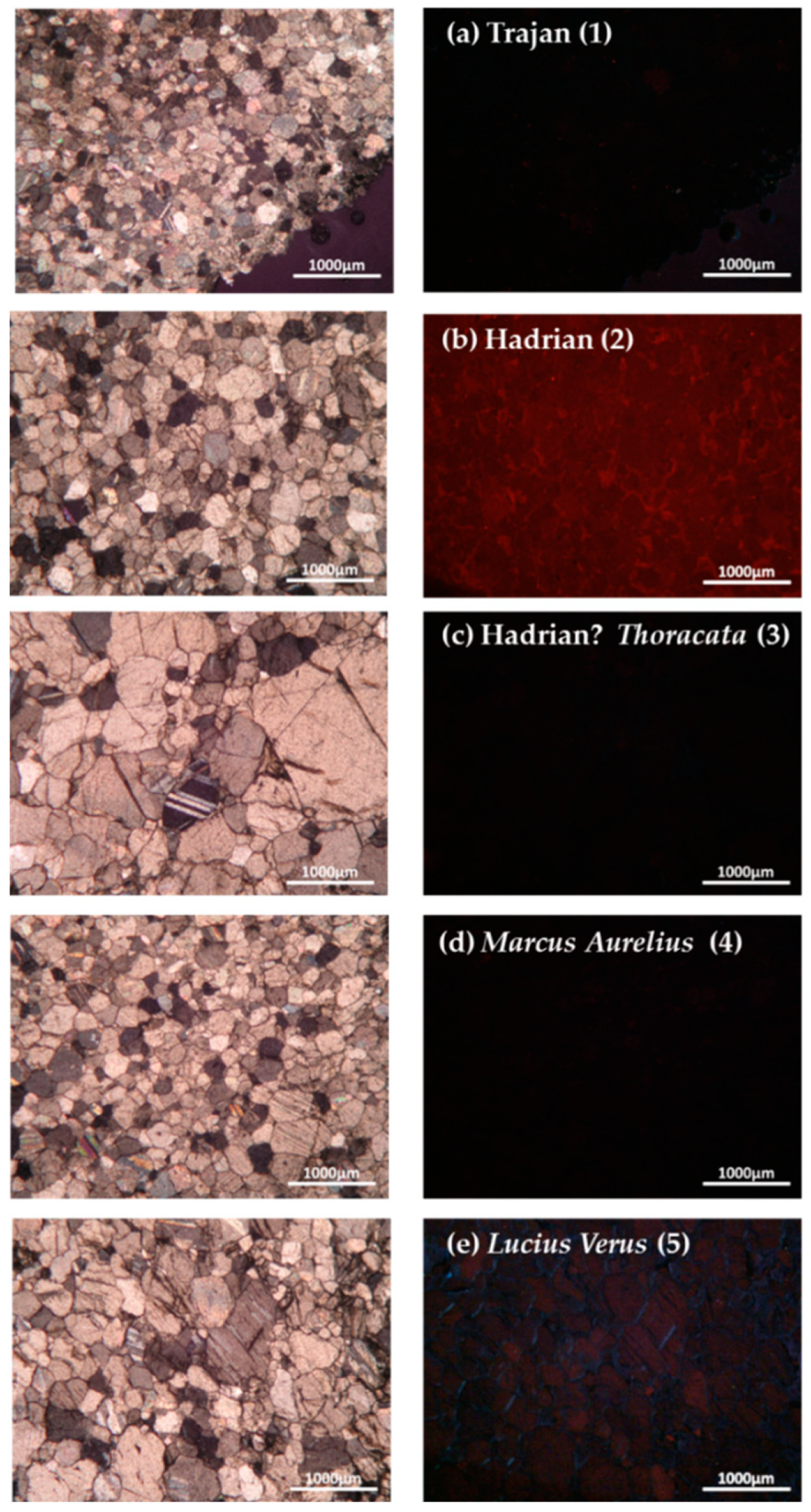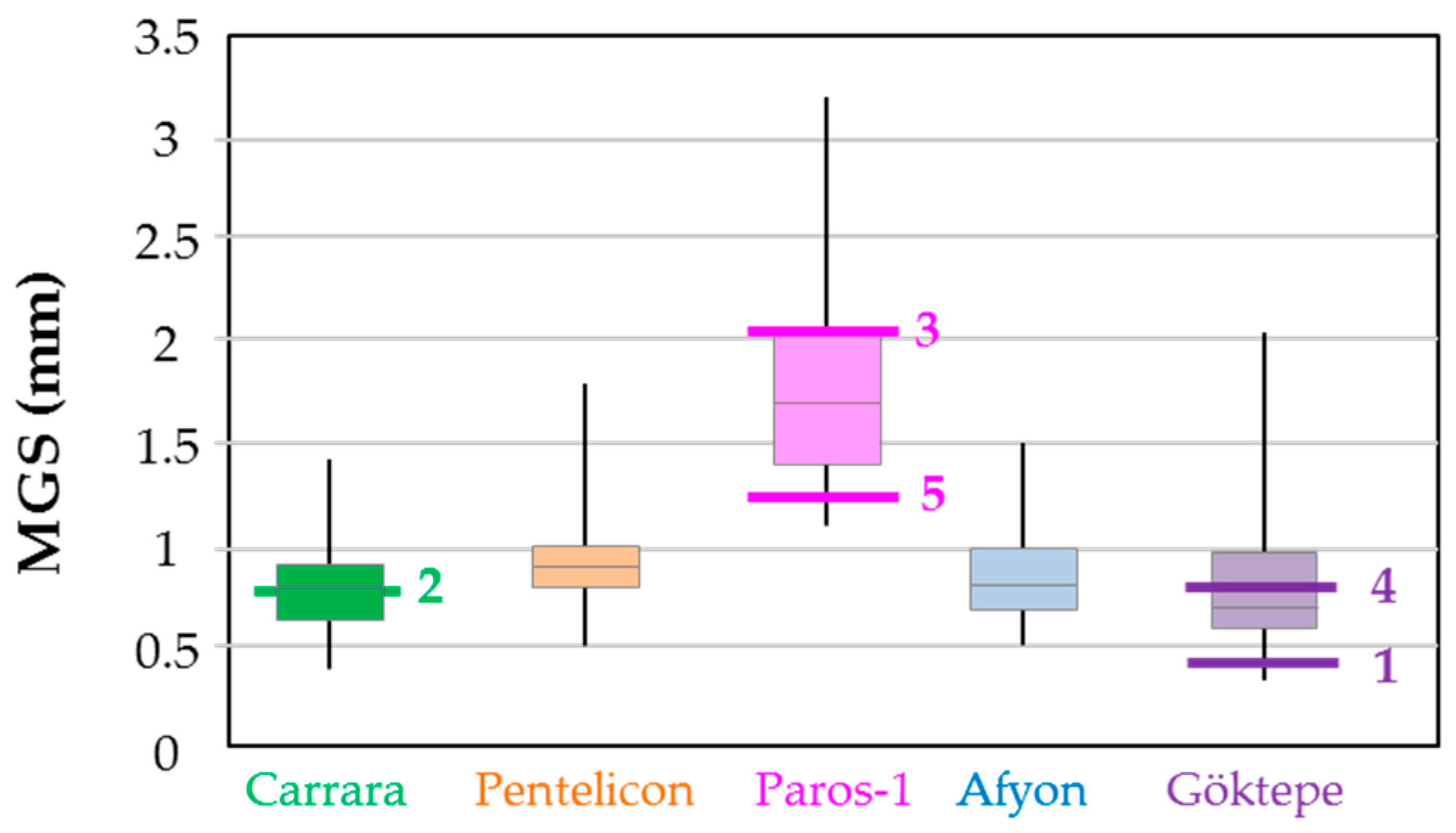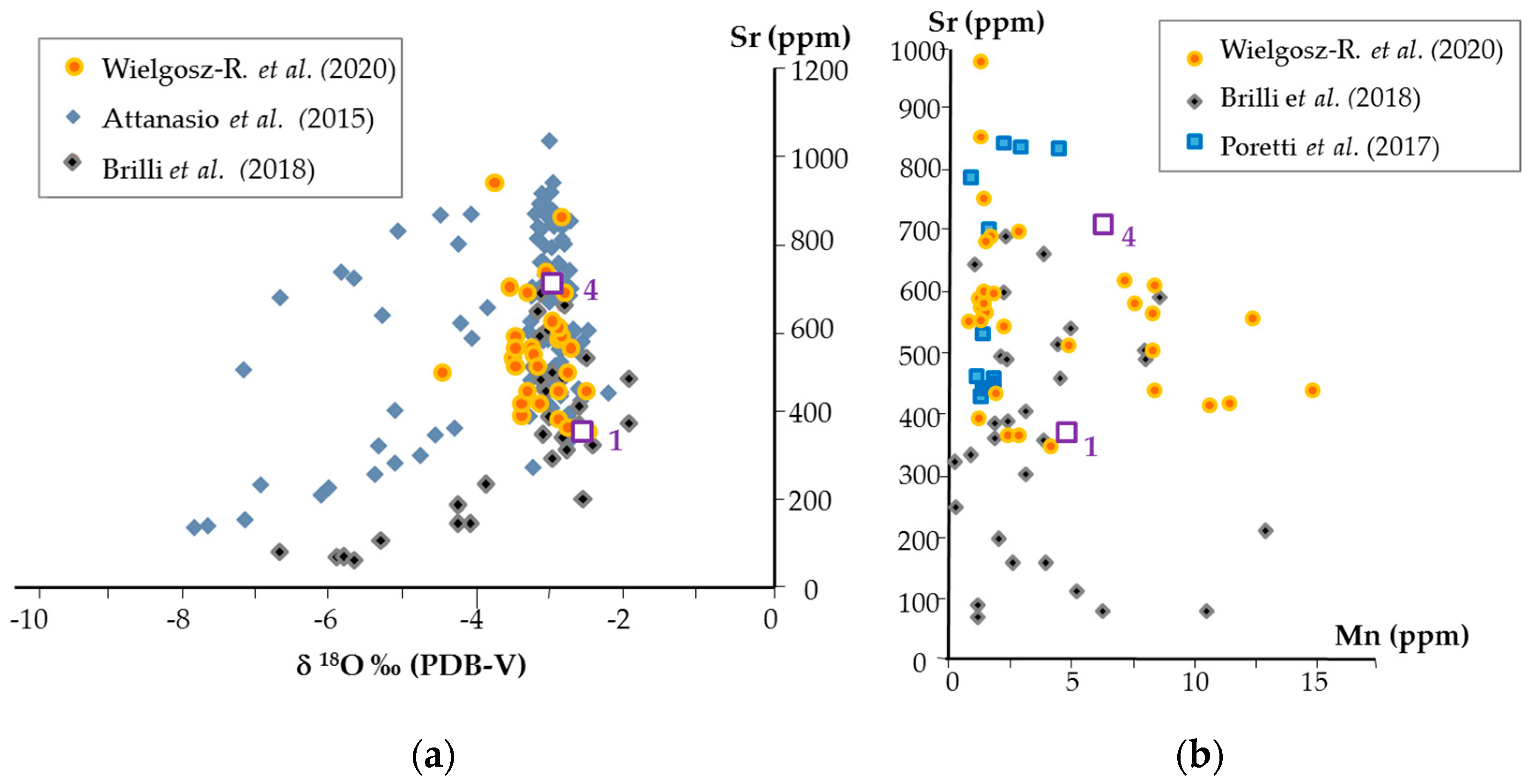A Multianalytical Approach to Identifying the White Marbles Used in Roman Imperial Sculptures from Tarraco (Hispania)
Abstract
:1. Introduction
2. Archaeological Pieces
2.1. Trajan (Sample 1) (Figure 1a)

2.2. Hadrian (Sample 2) (Figure 1b)
2.3. Hadrian? Bust (Sample 3) (Figure 1c)
2.4. Marcus Aurelius (Sample 4) (Figure 2a)

2.5. Lucius Verus (Sample 5) (Figure 2b)
3. Materials and Methods
4. Results and Discussion
4.1. Trajan (Sample 1)
4.2. Hadrian (Sample 2)
4.3. Hadrian? Thoracata (Sample 3)
4.4. Marcus Aurelius (Sample 4)
4.5. Lucius Verus (Sample 5)
5. Archaeological Considerations
6. Conclusions
Author Contributions
Funding
Data Availability Statement
Acknowledgments
Conflicts of Interest
References
- Fittschen, K.; Zanker, P. Katalog der Römischen Porträts in den Capitolonischen Museen und den Anderen Kommunalen Sammlungen der Stadt Rom I. Kaiser-und Prinzenbildnisse; Deutsches Archäologisches Institut, Philipp von Zabern: Mainz am Rhein, Germany, 1985. [Google Scholar]
- Fittschen, K. Prinzenbildnisse Antoninischer Zeit; Deutsches Archäologisches Institut, Philipp von Zabern: Mainz am Rhein, Germany, 1999. [Google Scholar]
- Fittschen, K. The Portraits of Roman Emperors and Their Families. In The Emperor and Rome: Space, Representation and Ritual; Ewald, B.C., Noreña, C.F., Eds.; Cambridge University Press: Cambridge, UK, 2010; pp. 221–246. [Google Scholar]
- Fittschen, K.; Zanker, P.; Cain, P. Katalog der Römischen Porträits in den Capitolinischen Museen und den Anderen Kommunalen Sammlungen der Stadt Rom IV; Kinderbildnisse: Berlin, Germany, 2014. [Google Scholar]
- Jucker, I. Skulpturen der Antiken-Sammlung Ennetwies I. Monumenta Artis Romanae XXV; Deutsches Archäologisches Institut, Philipp von Zabern: Mainz am Rhein, Germany, 1995. [Google Scholar]
- Evers, C. Les Portraits d’Hadrien. Typologie et Ateliers; Académie Royale de Belgique: Bruxelles, Belgium, 1994. [Google Scholar]
- Smith, R.R.R. AphrodisiasII. Roman Portrait Statuary from Aphrodisias; Philipp von Zabern: Mainz, Germany, 2006. [Google Scholar]
- Feijfer, J. Roman Portraits in Context; De Gruyter: Berlin, Germany, 2008. [Google Scholar]
- Trillmich, W.; Hesberg, H.; Nünnerich-Asmus, A. Denkmäler der Römerzeit; Hispania Antiqua; Philipp von Zabern: Mainz am Rhein, Germany, 1993. [Google Scholar]
- Koppel, E.M. Die Römischen Skulpturen von Tarraco; Madrider Forschungen, 25; De Gruyter: Berlin, Germany, 1985. [Google Scholar]
- Koppel, E.M. La Schola del Collegium Fabrum de Tarraco y su Decoración Escultórica. In Faventia Monografies; Universitat Autònoma de Barcelona: Bellaterra, Spain, 1988; Volume 7. [Google Scholar]
- Koppel, E.M. Técnicas escultóricas romanas: Tarraco. In Materiales y Técnicas Escultóricas en Augusta Emerita y Otras Ciudades de Hispania; Nogales, T., Ed.; Cuadernos Emeritenses 20; Museo Nacional de Arte Romano: Mérida, Mexico, 2002; pp. 49–70. [Google Scholar]
- Koppel, E.M. La escultura. In Las Capitales Provinciales de Hispania, 3. Tarragona, Colonia Iulia Urbs Triumphalis Tarraco; Dupré, X., Ed.; «L’Erma» di Bretschneider: Roma, Italy, 2004; pp. 111–122. [Google Scholar]
- Ojeda, D. Las representaciones estatuarias y los retratos de Trajano en Hispania: Una revisión. Arch. Español De Arqueol. 2010, 83, 267–280. [Google Scholar] [CrossRef]
- Nogales, T.; Rodà, I. Talleres escultóricos. In Artífices Idóneos: Artesanos, Talleres y Manufacturas en Hispania; Bustamante, M., Bernal, D., Eds.; Anejos Arch. Español de Arqueol. LXXI; Consejo Superior de Investigaciones Científicas: Mérida, Spain, 2014; pp. 75–103. [Google Scholar]
- Rodà, I. La escultura romana importada en Hispania Citerior. In Le Commerce Maritime Romain en Méditerrannée Occidental; Colloque International tenu à Barcelone du 16 au 18 mai 1988; Consejo de Europa: Barcelona, Spain, 1990; pp. 291–312. [Google Scholar]
- Garriguet, J.A. ¿Provincial o foráneo? Consideraciones sobre la producción y recepción de retratos imperiales en Hispania. In El Concepto de lo Provincial en el Mundo Antiguo. Homenaje a la Prof. Pilar León; Vaquerizo, D., Murillo, J.F., Eds.; Universidad de Córdoba: Córdoba, Spain, 2006; pp. 143–194. [Google Scholar]
- Garriguet, J.A. Retratos imperiales de Hispania. In Escultura Romana en Hispania, V. Actas de la Reunión Internacional (Murcia 2005); Noguera, J.M., Conde, E., Eds.; Tabularium: Murcia, Spain, 2008; pp. 115–147. [Google Scholar]
- Garriguet, J.A. Un posible retrato de Adriano en el Palacio de Viana (Córdoba). In Escultura Romana en Hispania VIII. Homenaje a Luís Baena del Alcázar. Actas de la VIII Reunión Internacional de Escultura Romana en Hispania, Universidad de Córdoba y Baena, 5 al 8 de Octubre de 2016; Márquez, C., Ojeda, D., Eds.; Ediciones Universidad de Córdoba: Córdoba, Spain, 2018; pp. 579–595. [Google Scholar]
- Noguera, J.M.; Ruiz, L. El retrato de Adriano de la villa de Los Torrejones (Yecla, Murcia) y su contexto arqueológico. In Escultura Romana en Hispania VIII. Homenaje a Luis Baena del Alcázar, Actas de la VIII Reunión Internacional de Escultura Romana en Hispania, Universidad de Córdoba y Baena, 5 al 8 de Octubre de 2016; Márquez, C., Ojeda, D., Eds.; Ediciones Universidad de Córdoba: Córdoba, Spain, 2018; pp. 299–317. [Google Scholar]
- Attanasio, D.; Bruno, M.; Prochaska, W. The Marbles of the Roman Villa of Chiragan at Martres-Tolosane (Gallia Narbonensis). AA 2016, 1, 169–200. [Google Scholar]
- Attanasio, D.; Bruno, M.; Prochaska, W. The marbles of Roman portraits. New data on the marble provenance of 261 imperial and private urban portraits dating from the mid 1st century B.C. to the early 6th century A.D. Jahrb. Dtsch. Archäologischen Inst. 2019, 134, 167–277. [Google Scholar]
- Attanasio, D.; Bruno, M.; Prochaska, W.; Yavuz, A.B. The marble of Roman Imperial portraits. In ASMOSIA XI, Interdisciplinary Studies of Ancient Stone, Proceedings of the Eleventh International Conference of ASMOSIA, Split, Croatia, 18–22 May 2015; Matetić Poljak, D., Marasović, K., Eds.; University of Split: Split, Croatia, 2018; pp. 185–194. [Google Scholar]
- Herrmann, J.J., Jr. Thasian Hadrians: Portraits of the emperor in dolomitic marble from Thasos. In ASMOSIA XII Proceedings of the XII ASMOSIA International Conference, (Izmir, Turkey 2018); Yavuz, A.B., Yolaçan, B., Bruno, M., Eds.; Dokuz Eylül University Pub.: Izmir, Turkey, 2023; pp. 95–104. [Google Scholar]
- Gutiérrez Garcia-Moreno, A.; Rodà, I. El mármol de Luni-Carrara en la fachada mediterránea de Hispania. In Rome, Portus and the Mediterranean; Keay, S., Ed.; The British School at Rome: Rome, Italy, 2012; pp. 293–312. [Google Scholar]
- Antonelli, F.; Lazzarini, L. Mediterranean trade of the most widespread Roman volcanic millstones from Italy and petrochemical markers of their raw materials. J. Archaeol. Sci. 2010, 37, 2081–2092. [Google Scholar] [CrossRef]
- Germinario, L.; Zara, A.; Maritan, L.; Bonetto, J.; Hanchar, J.M.; Sassi, R.; Siegesmund, S.; Mazzoli, C. Tracking trachyte on the Roman routes: Provenance study of Roman infrastructure and insights into ancient trades in northern Italy. Geoarchaeology 2018, 33, 417–429. [Google Scholar] [CrossRef]
- Dilaria, S.; Secco, M.; Ghiotto, A.R.; Furlan, G.; Giovanardi, T.; Zorzi, F.; Bonetto, J. Early exploitation of Neapolitan pozzolan (pulvis puteolana) in the Roman theatre of Aquileia, Northern Italy. Sci. Rep. 2023, 13, 4110. [Google Scholar] [CrossRef]
- Cazes, D.; Koppel, E.M.; Nogales, T.; Sada, P.; Tarrats, F. La Mirada de Roma: Retratos Romanos de los Museos de Mérida, Toulouse y Tarragona (Cat. expos.); Museo Nacional de Arte Romano–Musée de Toulouse/Musée Saint-Raymond–MNAT; Mérida–Toulouse–Tarragona: Mérida, Spain, 1995. [Google Scholar]
- Ruiz, J.C. Los retratos imperiales de Tarraco: Notas sobre talleres y técnicas de producción. Espac. Tiempo Y Forma 2018, 11, 75–99. [Google Scholar]
- Meyers, R. A New Analysis of Antonine Statuary Groups in Roman Spain. Am. J. Archaeol. 2019, 123, 127–155. [Google Scholar] [CrossRef]
- Cabrera, P.; Castellano, A.; Elvira, M.A.; Schöder, S.F.; Ruiz-Nicoli, B. Rostros de Roma. Retratos Romanos del Museo Arqueológico Nacional; Catálogo Exposición: Madrid, Spain, 2008. [Google Scholar]
- Lapuente, M.P. Archaeometry on stones. Multi-method approach to investigate stone provenance. Studied cases from Roman. Hispanic marmora. Archeometriai Muh. 2014, 11, 149–158. [Google Scholar]
- Brilli, M.; Lapuente Mercadal, M.P.; Giustini, F.; Royo Plumed, H. Petrography and mineralogy of the white marble and black stone of Göktepe (Muğla, Turkey) used in antiquity: New data for provenance determination. J. Archaeol. Sci. Rep. 2018, 19, 625–642. [Google Scholar] [CrossRef]
- Lapuente, P.; Royo, H. Cathodoluminescence for the characterization of ancient marble. Problems and research perspective. In Ancient Quarries and Building Sites in Asia Minor. Research on Hierapolis in Phrygia and Other Cities in South-Western Anatolia: Archaeology, Archaeometry, Conservation; Ismaelli, T., Scardozzi, G., Eds.; Edipuglia: Bari, Italy, 2016; pp. 541–548. [Google Scholar]
- Antonelli, F.; Lazzarini, L. An updated petrographic and isotopic reference database for white marbles used in antiquity. Rend. Lincei-Sci. Fis. 2015, 26, 399–413. [Google Scholar] [CrossRef]
- Blanc, P.; Lapuente Mercadal, M.P.; Gutiérrez Garcia, M.A. A new database of the quantitative cathodoluminescence of the main quarry marbles used in antiquity. Minerals 2020, 10, 381. [Google Scholar] [CrossRef]
- Brilli, M.; Lapuente Mercadal, M.P.; Giustini, F.; Royo Plumed, H. Reply to Comments on the paper “Petrography and Mineralogy of the white marble and black stone of Göktepe (Muğla, Turkey) used in antiquity: New data for provenance determination” by M. Brilli, M.P. Lapuente Mercadal, F. Giustini and H. Royo Plumed (JAS Reports 2018, 19, 625–642). J. Archaeol. Sci. Rep. 2020, 30, 102071. [Google Scholar] [CrossRef]
- Lapuente, M.P.; León, P.; Nogales, T.; Royo, H.; Preite Martinez, M.; Blanc, P. White sculptural materials from Villa Adriana: Study of provenance. In Interdisciplinary Studies on Ancient Stone, Proceedings of the IX ASMOSIA Conference, Tarragona, Spain, 8–13, June 2009; Gutiérrez Garcia, M.A., Lapuente, P., Rodà, I., Eds.; ICAC: Tarragona, Spain, 2012; pp. 364–375. [Google Scholar]
- Gorgoni, C.; Lazzarini, L.; Pallante, P.; Turi, B. An updated and detailed mineropetrographic and C–O stable isotopic reference database for the main Mediterranean marbles used in antiquity. In Interdisciplinary Studies on Ancient Stone; Asmosia 5; Herrmann, J.J., Jr., Herz, N., Newman, R., Eds.; Archetype Pub.: London, UK, 2002; pp. 115–131. [Google Scholar]
- Attanasio, D.; Bruno, M.; Prochaska, W.; Yavuz, A.B. A multi-method database of the black and white marbles of Göktepe (Aphrodisias), including isotopic, EPR, trace and petrographic data. Archaeometry 2015, 57, 217–245. [Google Scholar] [CrossRef]
- Prochaska, W.; Attanasio, D. The challenge of a successful discrimination of ancient marbles (part III): A databank for Aphrodisias, Carrara, Dokimeion, Göktepe, Hymettos, Parian Lychnites and Pentelikon. J. Archaeol. Sci. Rep. 2022, 45, 103582. [Google Scholar] [CrossRef]
- Prochaska, W. The use of geochemical methods to pinpoint the origin of ancient white marbles. Miner. Petrol. 2023, 117, 401–409. [Google Scholar] [CrossRef]
- Wielgosz-Rondolino, D.; Antonelli, F.; Bojanowski, M.J.; Gładki, M.; Göncüoğlu, M.C.; Lazzarini, L. Improved methodology for identification of Göktepe white marble and the understanding of its use: A comparison with Carrara marble. J. Archaeol. Sci. 2020, 113, 105059. [Google Scholar] [CrossRef]
- Gutiérrez Garcia, M.A.; Savin, M.C.; Cantin, N.; Boudoumi, S.; Lapuente, P.; Chapoulie, R.; Pianet, I. NMR as a new tool for cultural heritage application: The provenance of ancient white marbles. Archaeometry 2019, 61, 795–808. [Google Scholar] [CrossRef]
- Antonelli, F.; Nestola, F. An innovative approach for provenancing ancient white marbles: The contribution of x-ray diffraction to disentangling the origins of Göktepe and Carrara marbles. Sci. Rep. 2021, 11, 22312. [Google Scholar] [CrossRef]
- Lapuente, P.; León, P.; Nogales-Basarrate, T. Variedades de mármol escultórico de Villa Adriana. Un ejemplo de estudio arqueométrico. In Roma, Tibur, Baetica. Investigaciones Adrianeas; Hidalgo, R., León, P., Eds.; Universidad de Sevilla: Sevilla, Spain, 2013; pp. 210–225. [Google Scholar]
- Lapuente Mercadal, P. Analíticas marmóreas: Actualización de las variedades escultóricas de Villa Adriana. In Villa Adriana. Escultura de los Almacenes; Hispania Antigua, Serie Arqueológica, 9; León, P., Nogales, T., Eds.; “L’Erma” di Bretschneider: Rome, Italy, 2018; pp. 401–416. [Google Scholar]
- Lapuente Mercadal, M.P.; Nogales-Basarrate, T.; Carvalho, A. Mineralogical Insights to Identify Göktepe Marble in the Sculptural Program of Quinta Das Longas Villa (Lusitania). Minerals 2021, 11, 1194. [Google Scholar] [CrossRef]
- Lapuente, P.; Nogales-Basarrate, T.; Royo, H.; Brilli, M. White marble sculptures from the National Museum of Roman Art (Mérida, Spain): Sources of local and imported marbles. Eur. J. Miner. 2014, 26, 333–354. [Google Scholar] [CrossRef]
- Attanasio, D.; Brilli, M.; Ogle, N. The Isotopic Signature of Classical Marbles; “L’Erma” di Bretschneider: Rome, Italy, 2006. [Google Scholar]
- Poretti, G.; Brilli, M.; De Vito, C.; Conte, A.M.; Borghi, A.; Günther, D.; Zanetti, A. New considerations on trace elements for quarry provenance investigation of ancient white marbles. J. Cult. Herit. 2017, 28, 16–26. [Google Scholar] [CrossRef]
- Attanasio, D.; Bruno, M.; Yavuz, A.B. Quarries in the region of Aphrodisias: The black and white marbles of Göktepe (Muğla, Turkey). J. Rom. Archaeol. 2009, 22, 312–348. [Google Scholar] [CrossRef]
- Lapuente Mercadal, M.P.; Gutiérrez Garcia, M.A.; Noguera Celdrán, J.M.; Ruiz Molina, L. Archaeometric identification of Göktepe marble used in the Hadrian portrait of Los Torrejones (Yecla, Murcia) and some considerations on the presence of Göktepe marble in Hispania. Zephyrus. in press.
- Lapuente Mercadal, M.P.; Nogales-Basarrate, T. Statuary qualities of white and black Göktepe marble identified in the Hispanic Valdetorres de Jarama marble collection. Minerals. (forthcoming).





| Sample | MNAT | LEMLA | ICAC | Personage | Relevant References Pages (pp.); Number (num.); Plate (pl.); Idem (Id) | Chronology |
|---|---|---|---|---|---|---|
| 1 | 388 | 1139 | TAR-1254 | Trajan divus | [10], pp. 92–93, num. 124, pl. 53,3–6; [14], p. 268, num. 7, p. 271, figures 5a,b. | Hadrian age (c. 130–140 AD) |
| 2 | 389 | 1138 | TAR-1255 | Hadrian “Tarragona type” | [10], pp. 94–95, num. 126, pl. 55,1–4; [1], p. 58; [6], p. 186, num. 137. [17], p. 179, pl. XVII, 1–2; [29], p. 88; [19], pp. 583–584; [24], Herrmann 2023, p. 99. | Hadrian age (c. 130–140 AD) |
| 3 | 12261 | 1148 | TAR-1256 | Hadrian? Thoracata | [10], pp. 52–53, num. 76, pl. 25,1–2; [11], pp. 14–16, num. 2, pl. 5; [30], p. 52, num. 12. | Hadrian age (c. 117–135 AD) |
| 4 | 386 | 1137 | TAR-1257 | Marcus Aurelius | [10], pp. 33–34, num. 46, lam. 13; [30], p. 163, num. 116; [9], pp. 329–330, pl. 109; [5], p. 32, lam. 15, note 5; [2], p. 26, num. B 35, lam. 50; [17], pp. 173–174, pl. XIII, 1–2; [31], pp. 142–143, figure 12. | c. 152–160 AD |
| 5 | 387 | 1136 | TAR-1258 | Lucius Verus | [10], pp. 34–35, num. 47, pl. 14; [30], p. 120; Rodà 1990, p. 301; [12], p. 53; [17], pp. 173–174, 181–182, pl. XIX, 1–2; [31], p. 142–145, figure 13. | c. 161–169 AD |
| Sample Personage | MGS | MFS | GBS | Texture Fabric | Qualitative CL-Optical | Mineralogy | δ13C ‰ | δ18O ‰ | Sr ppm | Mn ppm | Marble Origin |
|---|---|---|---|---|---|---|---|---|---|---|---|
| 1. Trajan divus | 0.4 mm | Extremely fine (0.2 mm) | Curved to straight | Homeoblastic mosaic slightly strained | Low CL | Calcite | +2.8 | −2.6 | 379 | 4.7 | Göktepe wG1 type |
| 2. Hadrian “Tarragona type” | 0.7 mm | Very fine (0.4 mm) | Straight to curved | Homeoblastic polygonal mosaic | Low—Medium CL | Calcite Microdolomite | +2.1 | −1.0 | 136 | 36.8 | Carrara |
| 3. Hadrian? Thoracata | 2 mm | Fine–medium (0.7–1.8 mm) | Curved | Heteroblastic mosaic | Low—bluish CL | Calcite | +4.8 | −3.2 | Paros-1 Lychnites | ||
| 4. Marcus Aurelius | 0.7 mm | Very fine (0.4 mm) | Curved to straight | Homeoblastic polygonal mosaic | Very Low CL | Calcite | +2.6 | −3.0 | 713 | 6.3 | Göktepe wG2 type |
| 5. Lucius Verus | 1.2 mm | Very fine–fine (0.4–0.9 mm) | Curved to straight | Heteroblastic mosaic | Low—bluish CL | Calcite | +4.9 | −3.1 | Paros-1 Lychnites |
Disclaimer/Publisher’s Note: The statements, opinions and data contained in all publications are solely those of the individual author(s) and contributor(s) and not of MDPI and/or the editor(s). MDPI and/or the editor(s) disclaim responsibility for any injury to people or property resulting from any ideas, methods, instructions or products referred to in the content. |
© 2023 by the authors. Licensee MDPI, Basel, Switzerland. This article is an open access article distributed under the terms and conditions of the Creative Commons Attribution (CC BY) license (https://creativecommons.org/licenses/by/4.0/).
Share and Cite
Lapuente Mercadal, M.P.; Clavería, M.; Rodà, I. A Multianalytical Approach to Identifying the White Marbles Used in Roman Imperial Sculptures from Tarraco (Hispania). Minerals 2024, 14, 19. https://doi.org/10.3390/min14010019
Lapuente Mercadal MP, Clavería M, Rodà I. A Multianalytical Approach to Identifying the White Marbles Used in Roman Imperial Sculptures from Tarraco (Hispania). Minerals. 2024; 14(1):19. https://doi.org/10.3390/min14010019
Chicago/Turabian StyleLapuente Mercadal, M. Pilar, Montserrat Clavería, and Isabel Rodà. 2024. "A Multianalytical Approach to Identifying the White Marbles Used in Roman Imperial Sculptures from Tarraco (Hispania)" Minerals 14, no. 1: 19. https://doi.org/10.3390/min14010019
APA StyleLapuente Mercadal, M. P., Clavería, M., & Rodà, I. (2024). A Multianalytical Approach to Identifying the White Marbles Used in Roman Imperial Sculptures from Tarraco (Hispania). Minerals, 14(1), 19. https://doi.org/10.3390/min14010019







